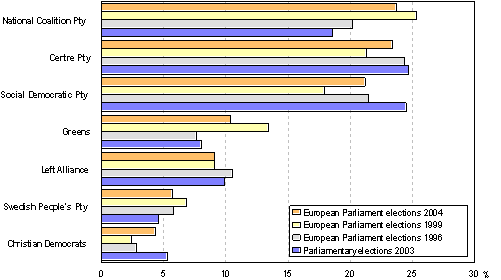The National Coalition Party, Centre Party and Social Democratic Party gained 11 MEPs in total and over two thirds of the votes
The National Coalition Party, Centre Party and Social Democratic Party gained altogether 11 of the 14 seats allocated to Finland and still kept their previous seats in the European Parliament. The Centre Party and Coalition Party both obtained four seats and the Social Democratic Party three. The Left Alliance and the Swedish People's Party in Finland also retained their former positions, both receiving again one MEP. Finland's loss of two seats in the European Parliament led to the defeat of the Green League and Christian Democrats in Finland. The Green League now has only one MEP, thus losing its second seat in the European Parliament and the Christian Democrats failed to keep the one seat they gained in the previous elections.
Finland's representatives are divided in the European Parliament into the following groups:
- Four MEPs of the National Coalition Party to the Group of the European People's Party (PPE-DE).
- Four Centre Party MEPs and one MEP of the Swedish People's Party to the European Liberal Democrats (ELDR).
- Three MEPs of the Social Democratic Party to the Socialist Group (PSE).
- One Green League MEP to the Group of the Greens (Verts/ALE).
- One MEP of the Left Alliance to the European United Left (GUE/NGL).
The three largest parties collected a total of 68.3 per cent of the votes cast
The National Coalition Party was the election winner with 392,771 votes, which was 23.7 per cent of all votes cast. In comparison with the previous European Parliament elections, votes cast for it fell slightly, by 1.6 percentage points. From the most recent elections, Parliamentary elections 2003, the number of votes cast for the Coalition Party rose most compared with all other parties, by 5.1 percentage points.
The Centre Party of Finland received the second highest number of votes, 387,217 (23.4%). The number of votes cast for it increased from the previous corresponding elections by 2.1 percentage points. Compared with the Parliamentary elections 2003 (24.7%), the support given to the Centre Party fell by 1.3 percentage points.
The Social Democratic Party of Finland gained 350,525 votes, which was 21.2 per cent of all votes cast. The number of votes cast for it rose by 3.3 per cent from the preceding European Parliament elections, but fell by 3.3 percentage points compared with the Parliamentary elections 2003 (24.5%).
The Green League received 172,844 votes, or 10.4 per cent of the votes cast. The number of votes cast for the party was the fourth highest as in the previous European Parliament elections, but of all parties it lost most of its support, by 3.0 percentage points. Compared with the Parliamentary elections 2003, the number of votes cast for the Green League rose by 2.4 percentage points.
The number of votes cast for the Left Alliance was 151,291, that is, 9.1 per cent of all votes cast. The party's support remained almost unchanged compared with the preceding European Parliament elections (up by 0.1 percentage points), but dropped slightly from the Parliamentary elections 2003 (by -0.8 percentage points).
The Swedish People's Party in Finland received 94,421 votes and its proportion of votes cast was 5.7 per cent. The number of votes cast for the Swedish People's Party declined by 1.1 percentage points compared with the European Parliament elections 1999, but rose by 1.1 percentage points from the Parliamentary elections 2003.
Votes cast for the major parties in European Parliament elections 2004, 1999 and 1996 and in Parliamentary elections 2003

Votes cast for the major parties in European Parliament elections 2004, 1999 and 1996 and in Parliamentary elections 2003
| European elections | European elections | European elections | Parliamentary elections | |
| 2004 | 1999 | 1996 | 2003 | |
| KOK | 23.7 | 25.3 | 20.2 | 18.6 |
| KESK | 23.4 | 21.3 | 24.4 | 24.7 |
| SDP | 21.2 | 17.9 | 21.5 | 24.5 |
| Greens | 10.4 | 13.4 | 7.6 | 8.0 |
| Left | 9.1 | 9.1 | 10.5 | 9.9 |
| RKP | 5.7 | 6.8 | 5.8 | 4.6 |
| KD | 4.3 | 2.4 | 2.8 | 5.3 |
Table: Votes cast for the parties and percentages in European Parliament elections 2004, 1999 and 1996 and in Parliamentary elections 2003 (Excel table)
Voting turnout (41.1%) rose higher than in the previous elections
Voting turnout was good compared with the previous European Parliament elections in 1999. Voting turnout rose in the whole country by nearly ten percentage points (9.7%) while the number of voters was over 400,000 higher than in 1999.
Voting turnout increased throughout the country but it grew more than average in the constituencies of Southern Finland (by over 11 percentage points) and Vaasa (by more than 10 percentage points). Voting turnout was the highest in the constituency of Helsinki, where it climbed over 50 per cent (52.3%). The second best percentage (45.8%) was attained in the constituency of Uusimaa. Voting turnout of 40 per cent was also achieved in the constituencies of Vaasa (44.4%) and Varsinais-Suomi (41.5%). Voting was the least active in the constituencies of North Karelia (32.6%) and North Savo (34.6%). Of individual municipalities, voting turnout was the highest in the country in Kauniainen (69.1%) and the lowest in the municipality of Rautavaara (24.8%).
Last updated 14.1.2005
Contact InformationElection statistics
Telephone (09) 1734 1
E-mail: vaalit.tilastokeskus@tilastokeskus.fi
Statistics:
(none) [e-publication].
(none),
The National Coalition Party, Centre Party and Social Democratic Party gained 11 MEPs in total and over two thirds of the votes
. Helsinki: (none) [referred: 29.12.2025].
Access method: http://stat.fi/til/euvaa/2004/euvaa_2004_2004-06-23_kat_001_en.html
